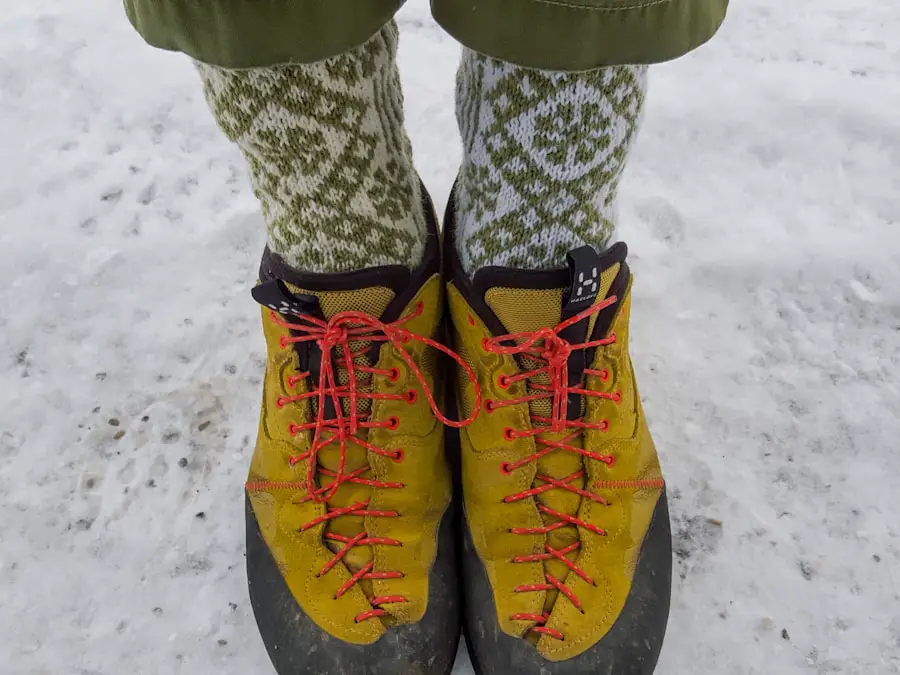Properly lacing hiking boots is a fundamental aspect of ensuring comfort and safety during outdoor adventures. The way boots are laced can significantly affect how they fit, how well they support the foot, and how effectively they protect against injuries. A well-laced boot can provide the necessary stability to navigate uneven terrain, while a poorly laced boot can lead to discomfort, blisters, and even accidents.
When hiking, the feet endure a considerable amount of stress, and the right lacing technique can help distribute this pressure evenly across the foot, reducing the risk of fatigue and injury. Moreover, the importance of lacing extends beyond mere comfort; it also plays a crucial role in enhancing performance. A secure fit allows for better control over foot movements, which is essential when traversing rocky paths or steep inclines.
When boots are laced correctly, hikers can maintain their footing more effectively, which is vital for both speed and safety. In essence, the act of lacing boots is not just a preparatory step; it is an integral part of the hiking experience that can influence the overall enjoyment and success of a trek.
Key Takeaways
- Properly lacing hiking boots is crucial for comfort, support, and preventing injuries during outdoor activities.
- Different lacing techniques can provide a customized fit for various foot shapes and sizes, as well as different terrains.
- Achieving a secure fit is essential for preventing blisters and hotspots, which can be achieved through proper lacing and boot adjustment.
- Adjusting lacing for uphill and downhill terrain can improve stability and prevent foot slippage, reducing the risk of injury.
- Utilizing lock lacing can add extra stability and support to the ankle, especially for those with weak or unstable ankles.
Understanding Different Lacing Techniques
There are various lacing techniques that cater to different foot shapes, hiking conditions, and personal preferences. The most common method is the standard crisscross lacing, where the laces cross over each other as they ascend the boot. This technique provides a balanced fit and is suitable for most hikers.
However, for those with specific needs, alternative methods can offer enhanced support or comfort. For instance, the straight lacing technique is often recommended for individuals with high arches or sensitive feet, as it reduces pressure on the top of the foot while still securing the boot effectively. Another popular technique is the heel lock or lace lock method, which is particularly beneficial for those who experience heel slippage.
This technique involves creating a loop with the laces at the top eyelets before threading them through to secure the heel in place. By preventing unnecessary movement within the boot, this method enhances stability and reduces the risk of blisters caused by friction. Understanding these various techniques allows hikers to tailor their lacing approach to their unique foot characteristics and hiking conditions.
Tips for Achieving a Secure Fit

Achieving a secure fit when lacing hiking boots involves more than just pulling the laces tight; it requires attention to detail and an understanding of how different parts of the boot interact with the foot. One effective tip is to start lacing from the bottom up, ensuring that each eyelet is threaded evenly and that there are no twists in the laces. This foundational step helps create a uniform tension across the entire boot, which is crucial for maintaining stability during hikes.
Additionally, hikers should consider adjusting their lacing tension based on their activity level. For instance, when embarking on a steep ascent, it may be beneficial to tighten the laces more securely to prevent any unwanted movement. Conversely, during flat stretches or descents, slightly loosening the laces can enhance comfort and allow for better blood circulation in the feet.
This dynamic approach to lacing not only improves fit but also contributes to overall foot health during long hikes.
How to Prevent Blisters and Hotspots
| Preventive Measures | Effectiveness |
|---|---|
| Wearing moisture-wicking socks | Reduces friction and moisture, decreasing the likelihood of blisters |
| Properly fitting shoes | Minimizes rubbing and pressure points on the feet |
| Using blister pads or moleskin | Provides a protective barrier to prevent friction |
| Applying lubricants or powders | Reduces friction and moisture, preventing hotspots and blisters |
| Taping problem areas | Provides extra support and reduces friction on vulnerable areas |
Blisters and hotspots are common issues that many hikers face, often resulting from friction between the foot and the boot. To prevent these painful occurrences, proper lacing techniques play a pivotal role. One effective strategy is to ensure that the laces are not too tight in certain areas while remaining secure overall.
For example, if the laces are overly tight across the instep, it can create pressure points that lead to hotspots. By adjusting tension in specific areas, hikers can minimize friction and enhance comfort. In addition to adjusting lacing techniques, choosing appropriate socks can also significantly reduce the risk of blisters.
Opting for moisture-wicking materials that provide cushioning can help absorb impact and reduce friction against the skin. Furthermore, applying blister prevention products such as blister pads or specialized creams can offer an extra layer of protection. Combining these strategies with proper lacing techniques creates a comprehensive approach to preventing blisters and ensuring a more enjoyable hiking experience.
Adjusting Lacing for Uphill and Downhill Terrain
The terrain plays a crucial role in determining how hikers should lace their boots for optimal performance. When ascending steep inclines, it is essential to achieve a snug fit around the ankle to prevent any heel lift that could lead to instability or loss of balance. Tightening the laces around the ankle area helps secure the foot in place, allowing for better control over movements and reducing the risk of slipping.
Conversely, when descending steep slopes, hikers may benefit from slightly loosening their laces to allow for more flexibility in the forefoot area. This adjustment can help accommodate natural foot expansion that occurs during downhill movement while still providing adequate support. Additionally, some hikers find it helpful to use a technique called “downhill lacing,” where they skip one or two eyelets at the top of the boot to create more room for movement without sacrificing overall stability.
By adapting lacing techniques based on terrain, hikers can enhance their safety and comfort during challenging hikes.
Utilizing Lock Lacing for Added Stability

Lock lacing is an advanced technique that offers additional stability and security for hikers who require extra support during their treks. This method involves creating a locking mechanism at the top of the boot by threading the lace through an additional loop created by crossing over at the last eyelet before tying off. This technique effectively prevents heel lift and keeps the foot firmly in place within the boot.
The benefits of lock lacing extend beyond just stability; it also helps distribute pressure evenly across the foot, reducing discomfort during long hikes. Hikers who frequently navigate rugged terrain or carry heavy packs may find this technique particularly advantageous as it minimizes movement within the boot and enhances overall control. By incorporating lock lacing into their routine, hikers can experience improved performance and reduced fatigue on challenging trails.
Customizing Lacing for Foot Shape and Size
Every hiker has unique foot shapes and sizes that may require customized lacing techniques for optimal comfort and support. For individuals with wider feet, using a skipping method where certain eyelets are left unlaced can create additional space in critical areas without compromising overall fit. This approach allows for better circulation and reduces pressure points that could lead to discomfort during long hikes.
Conversely, those with narrower feet may benefit from crisscrossing their laces more tightly in specific areas to achieve a snugger fit. This customization ensures that there is minimal movement within the boot while still allowing for adequate flexibility in other areas. Additionally, using different types of laces—such as flat or round—can also impact how well boots conform to individual foot shapes.
By experimenting with various lacing techniques and materials, hikers can find a personalized approach that enhances their overall hiking experience.
Maintenance and Care for Laces and Eyelets
Maintaining hiking boot laces and eyelets is essential for ensuring longevity and performance during outdoor activities. Regularly inspecting laces for fraying or wear is crucial; damaged laces can compromise both fit and safety on trails. If any signs of wear are detected, replacing them promptly will prevent potential issues during hikes.
Additionally, keeping laces clean from dirt and debris not only prolongs their lifespan but also ensures smooth adjustments when tightening or loosening them. Eyelets also require attention as they play a vital role in securing laces effectively. Over time, eyelets can become damaged or corroded due to exposure to moisture or rough terrain.
Regularly checking eyelets for any signs of wear or damage will help maintain their functionality. If any eyelets are found to be compromised, replacing them or seeking professional repair services can prevent further issues down the line. By prioritizing maintenance and care for both laces and eyelets, hikers can ensure that their boots remain reliable companions on every adventure.
If you’re looking for the best way to lace hiking boots, you may also be interested in finding the best sleeping bag for your backpacking adventures. Check out this article on the best sleeping bag for backpacking travel to ensure you stay warm and comfortable during your outdoor excursions. Properly lacing your hiking boots and having a quality sleeping bag are essential for a successful and enjoyable hiking experience.
Love travel? Join Our Facebook Community For More Tips.
FAQs
What are the benefits of lacing hiking boots properly?
Properly lacing hiking boots can provide better support, prevent blisters, and improve overall comfort and stability while hiking.
What is the best lacing technique for hiking boots?
The most common lacing technique for hiking boots is the “heel lock” or “lace lock” method, which helps to prevent heel slippage and provides a secure fit.
How tight should hiking boots be laced?
Hiking boots should be laced snugly but not too tight, allowing for some flexibility and movement while providing support and stability.
Are there different lacing techniques for different foot types?
Yes, there are different lacing techniques that can be used to accommodate different foot types, such as high arches, wide feet, or narrow heels.
Can lacing hiking boots improperly cause discomfort or injury?
Yes, improperly lacing hiking boots can cause discomfort, blisters, and even lead to foot or ankle injuries while hiking.
Are there specific lacing techniques for preventing toe pain or black toenails?
Yes, there are lacing techniques, such as the “window lacing” method, that can help alleviate pressure on the toes and prevent black toenails while hiking.
